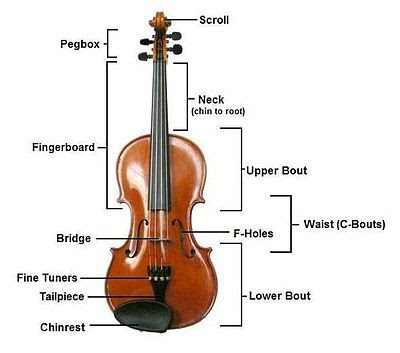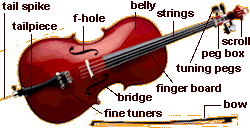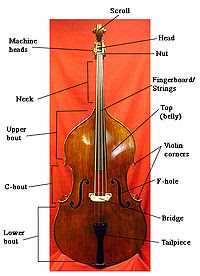 String family
String family(In order of pitch: high - low, determined by size)
Violin

Viola
(Same shape and features as the Violin only the Viola has a bigger body)
Cello

Double Bass

Articulation:
Arco normal (using the bow normally on the string)
Arco spiccato (the bow lightly bounces on the string)
Arco staccato ('detatched')
Arco legato ('tied together', smooth/joined)
Arco glissando ('to glide')
Arco sul tasto (''on the touch', to bow on the fingerboard)
Arco au talon (using the frog/nut of the bow on the string)
Arco punta d'arco ('at the point', using the point/tip of the bow)
Arco tremolo (measured/unmeasured) (alternating up and down bow rapidly)
Arco col legno (battuto/tratto) ('hit with wood')
Arco detache ('separated')
Arco Martele ('hammered', bow stroke with a bite to begin with)
Arco trill (rapidly alternating between two notes)
Arco sul ponticello ('on the bridge')
Arco tenuto ('to hold', sustain)
Pizzicato normal (plucking the string)
Pizzicato glissando
Pizzicato quasi guitar (held like a guitar and strummed)
Pizzicato tremolo
Molto vibrato (Molto='much', vibrato is a technique used to alternate pitch whilst bowing on the string)
Non vibrato (no vibrato)
Con sordino ('with mute')
Natural harmonic (placing a finger lightly on certain areas of the string without adding pressure to create a soft high-pitched note, usually around 1/4, 1/2 and 3/4 up a string, shortening the vibrational length of the string)
Artificial harmonic (the same effect as a natural harmonic, canceling out the fundamental tone, producing harmonic tones)
Harmonic glissando (gliding with harmonics)









